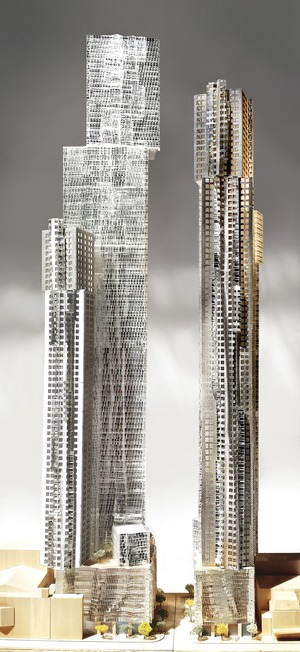

If all goes according to plan, architect Frank Gehry's second high-rise building, a 305-meter-tall skyscraper currently entering its schematic design phase, would become, at 305 meters, Canada's tallest building. The planned residential building, which received Toronto City Council approval in July, is expected to be under construction in 2016 and take four and a half years to build.
"In Toronto, there's a new paradigm," says Peter Kofman, president of Projectcore Inc., the developer, in conjunction with owner- developer David Mirvish, development and project manager for Mirvish + Gehry, Toronto. "Buildings are getting taller," he adds.
Currently, Canada's tallest building is Toronto's 298.1-meter First Canadian Place, which ranks at No. 88 in the Council on Tall Buildings and Urban Habitat's list of the 100 Tallest Completed Buildings in the World.
The Gehry Partners LLP Toronto tower is part of a 121,470-sq-m multi-use development that also includes a 275-m residential tower across the street from the 305-m tower.
Thanks to their many asymmetrical folds and creases, the towers' are reminiscent of the 85-year-old Gehry's first high-rise: the 265-m so-called New York by Gehry at 8 Spruce Street, completed in 2011 (ENR 3/29/10 p. 26). "We want to do something as spectacular in Toronto," says Kofman, who studied the New York building.
Agha Hasan, group leader for tall buildings in WSP's Toronto office, says Gehry's folds and creases "should help with the wind by breaking it up rather than letting it establish itself."
For the 305-m tower, WSP is developing a 12,000-psi reinforced-concrete shear-wall structure, with wall outriggers at the ninth and 50th mechanical levels. The slender tower, with 15,000-sq-ft floor plates, needs damping to handle wind vibrations, says Hasan.
WSP is considering either a sloshing-liquid damper at the top or distributed damping, which would replace 25% of the link beams with elements that have viscoelastic material built into them. WSP plans to handle the floor plates' "twists and turns" through post- tensioned transfer slabs at setbacks.
The project will be phased, with the 305-m tower rising first. Schematic design should last six months. Kofman has not yet decided whether or not Projectcore will also manage construction.


Post a comment to this article
Report Abusive Comment